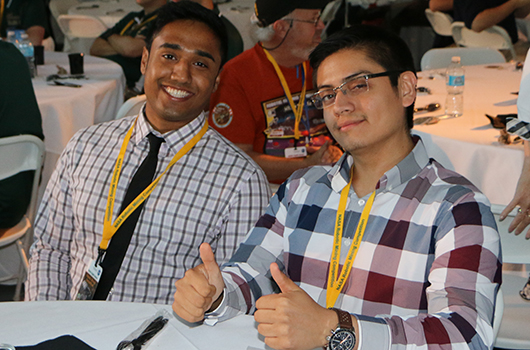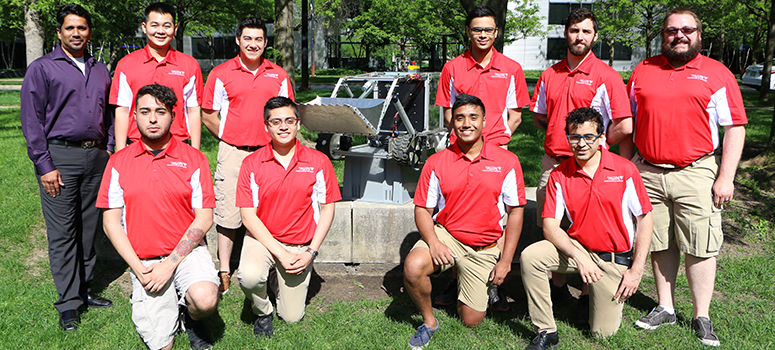 When Pedro Morales (EE 4th year) and Shawn Zachariah (EE 4th year) stepped foot on NASA’s Kennedy Space Center (KSC) at the end of last May, it was the culmination of months of planning, recruiting, building, and testing. The two students are the founding members of the Scarlet Space Hawks, the first Illinois Institute of Technology team to compete in NASA’s Annual Robotic Mining Competition (RMC). The competition challenges teams to build a robot that can be operated remotely to traverse a simulated Martian environment, mine regolith simulant (crushed rock), and return the excavated regolith for deposit in a collector. A total of 45 collegiate teams from all over the country participated in this year’s competition. Five teams, including the Illinois Tech team, were new to the competition.
When Pedro Morales (EE 4th year) and Shawn Zachariah (EE 4th year) stepped foot on NASA’s Kennedy Space Center (KSC) at the end of last May, it was the culmination of months of planning, recruiting, building, and testing. The two students are the founding members of the Scarlet Space Hawks, the first Illinois Institute of Technology team to compete in NASA’s Annual Robotic Mining Competition (RMC). The competition challenges teams to build a robot that can be operated remotely to traverse a simulated Martian environment, mine regolith simulant (crushed rock), and return the excavated regolith for deposit in a collector. A total of 45 collegiate teams from all over the country participated in this year’s competition. Five teams, including the Illinois Tech team, were new to the competition.
Although they were a rookie team, the Scarlet Space Hawks were able to place third in the Robotic On-Site Mining portion of the competition, collecting a combined 73 kg over two runs. To earn this accolade the team had to pass robot and communication inspections, mine more than 10 kg of regolith, efficiently use bandwidth, minimize robot mass, report energy consumed, have a dust tolerant design, perform dust free operations, perform tele-robotic and/or autonomously, and mine the third most resources.
Morales and Zachariah are both undergraduate transfer students that first met while taking courses at Oakton Community College prior to attending Illinois Tech. The pair found time to join Oaktobotics, a robotics team on the Oakton campus, between taking courses full-time and working part-time in on-campus jobs. As members of the team, they both discovered their deep passion for robotics.
Morales and Zachariah competed with the Oaktabotics team at the NASA RMC in 2016. Their team placed second in the overall competition that year out of 45 schools and outperformed the robots entered by many big-name engineering schools. Later that summer, as the two students began their transition to Illinois Tech, they knew they had to start an RMC team at Illinois Tech.
Before they set foot on campus they reached out to Ashfaq Khokhar, who at that time was department chair of the Department of Electrical and Computer Engineering (ECE), to see how they could initiate the team. Khokhar was very enthusiastic about the project and suggested that Associate Professor of Electrical and Computer Engineering Mahesh Krishnamurthy would be the perfect faculty advisor to the group.
Krishnamurthy provided guidance to the students on how to organize and structure the team and suggested new ways to attract followers. The two transfer students started recruiting others to join the team in the fall of 2016. “As a transfer student, organizing and participating in RMC gave me the opportunity to familiarize myself with the faculty and students on campus as well as all the facilities available for all students,” says Morales. As their team grew in size, they knew the next obstacle to tackle was to find funding to build the robot.
2017 Scarlet Space Hawks

View a photo album of the team’s adventure.
In October the group submitted their proposal to the Student Government Association to officially become a registered student group. Their proposal was accepted– but as a first year group they were only eligible for a portion of the funding they needed. They knew they were going to have to get creative.
After strategizing their next move, the team collectively registered for the Interprofessional Project (IPRO-497-242) in the spring 2017 semester. IPRO courses at Illinois Tech provide an interdisciplinary team of students with the chance to tackle a real world design and engineering problem. The course was led and developed by Krishnamurthy to design the RMC team’s robot and Society of Automotive Engineers (SAE) electric racecar. This move helped the team gain additional funding to build the robot, provided them with the expertise and support of IPRO staff, and helped the team gain insight from students outside of engineering.
Worried that they may have to forfeit their place in the competition due to incomplete funds, the Scarlet Space Hawks petitioned the Finance Board for more funding. The team demonstrated the importance of their goal and was awarded the remainder of their funding to build their robot and travel to Cape Canaveral for the competition. During this time, the group also applied for and was awarded funding through Armour College of Engineering’s Student Funding Program. This program provides funding to Armour students and engineering student groups to complete special projects and events.
As the team members were organizing their team and seeking funding, they learned skills that aren’t traditionally covered in the engineering curriculum. “I learned a lot about managing a team of over 15 people, fundraising, and overseeing a budget; all while being a full-time student and following NASA regulations, said Zachariah, “it was especially nerve racking knowing that a single missed deadline would force the team to forfeit the competition.”
As the group was busy seeking funding and recruiting members between September 2016 and March 2017, they were also putting in a large amount of time designing and planning their robot. The group held mandatory weekly meetings throughout the year for four hours every Thursday and another four hours each Saturday where team members could drop by at their leisure.
With the funding in place and the design nailed down, the team could now focus their efforts on building the robot, a journey that will be covered in part two, to be published on Thursday, September 28, 2017.
If you are interested in joining the group, please email Shawn Zachariah or Pedro Morales or connect with the team on Facebook.
